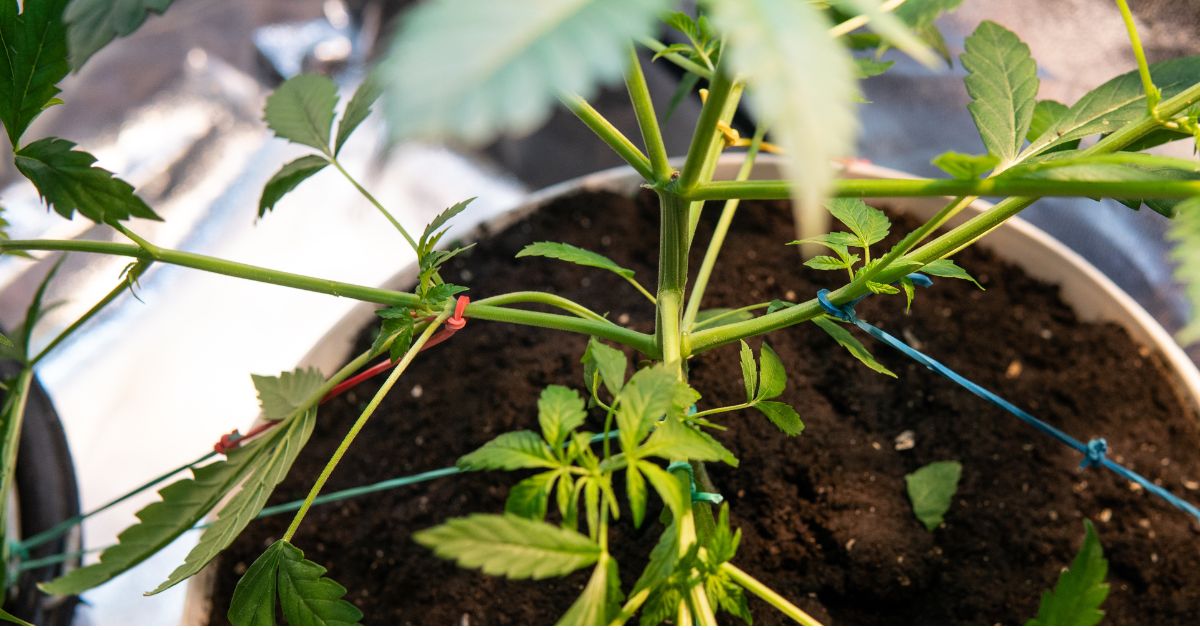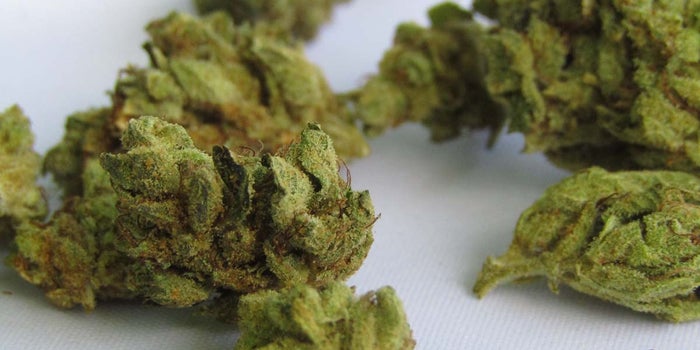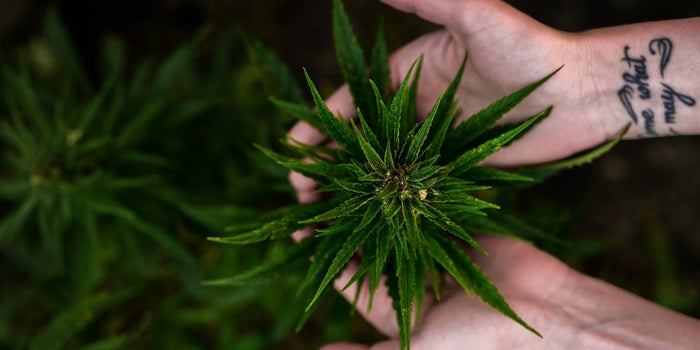Table of Contents
Low-Stress Training (LST) is a popular gardening technique that contrasts with High-Stress Training (HST) methods. Both forms of stress training involve manipulating plant growth to improve health, growth, and overall yield. LST is particularly effective for optimizing limited space and resources in indoor growing environments. In this article, we’ll explore the LST training method, its benefits, how to perform it, tools you’ll need, tips for success, common mistakes to avoid, and recovery. Let’s dive in!
What is LST?
Low-Stress training is a technique that involves gently bending and tying branches to create an even canopy, allowing all parts of the plant to receive equal amounts of light. This training method counteracts apical dominance, which is the natural tendency for the top of the plant to grow more vigorously than side branches. By addressing this issue, LST encourages the growth of multiple bud sites, increasing overall yield. This technique is prevalent among cannabis growers, but it can also be applied to other plants.
What are The Benefits of LST
- Accelerated Growth: One of the most significant advantages of LST is its ability to boost the growth rate of your plants. LST helps plants grow faster and more efficiently by maximizing light exposure and improving energy utilization. As all parts of the plant receive equal light, photosynthesis is optimized, leading to accelerated growth and a healthier plant overall.
- Increased Yields: LST enables the plant to produce more buds or fruits by creating a balanced canopy. This results in a higher overall yield and maximizes your indoor growing space. In addition, the even distribution of light ensures that every part of the plant can contribute to the bountiful harvest you’ll enjoy.
- Optimal Light Penetration: LST ensures that all plant parts receive equal amounts of light by creating an even canopy. This means that light is used more effectively, reducing the chances of it being wasted or blocked by taller branches. The improved light penetration also leads to a more uniform growth pattern, making managing and maintaining your plants easier.
- Enhanced Flavour and Potency: When buds or fruits receive optimal light exposure and nutrients, their flavour and potency can improve significantly. LST allows for better distribution of light and nutrients, which enhances the final product’s quality. This mainly benefits cannabis growers, often seeking to produce the most flavorful and potent buds possible.
- Efficient Use of Space: LST is an excellent technique for growers working with limited space, such as those in indoor growing environments. By training your plants to grow horizontally rather than vertically, you can make better use of the available space and potentially grow more plants. This not only maximizes your growing area but also helps optimize your garden’s overall efficiency.
By embracing the benefits of Low-Stress Training, you can take your indoor growing experience to new heights. This gentle yet effective technique has the potential to transform your garden, leading to healthier plants, increased yields, and a more enjoyable gardening experience. So why not try LST and see the difference it can make in your garden?
How to Start LST
Choosing the Right Plant: Start by selecting a plant that responds well to LST. Most plants can benefit from this technique, but some are more suitable than others.
Setting Up the Environment: Create a suitable environment for your plant by providing the necessary light, temperature, humidity, and ventilation for indoor growing.
Timing: The best time to start low-stress training is when the plant has developed a few sets of leaves and is strong enough to handle gentle bending. Typically, you should start LST before the plant enters the flowering stage.
The LST Process: Begin by carefully bending the plant stem or branches and securing them in place with soft plant ties. Gradually adjust the ties as the plant grows, maintaining the desired shape.
Tools
To successfully perform Low-Stress Training (LST) on your plants, you will need the following tools:
- Soft Plant Ties: These are used to gently secure the branches in their desired positions without damaging the plant. Plant ties made of soft materials, such as Velcro, rubber, or cloth, are ideal.
- Garden Wire: You can use flexible garden wire if you don’t have soft plant ties. Make sure to choose a wire with a soft coating to prevent damage to the plant.
- Stakes or Hooks: These can anchor the plant ties, helping maintain the desired shape and position of the branches. Choose stakes or hooks made of materials that won’t damage your plant, such as plastic or bamboo.
- Pruning Shears: A clean, sharp pair of pruning shears are essential for trimming and removing unnecessary growth. This helps maintain an even canopy and directs the plant’s energy toward the desired branches.
- Gloves: Wearing gloves while working with your plants can help protect your hands and minimize the risk of transferring pathogens or pests to your plants.
- Plant Labels: Labeling your plants can be helpful, especially when you’re growing multiple strains or varieties. This will help you keep track of which plants have received LST and any specific care requirements.
With these tools, you’ll be well-prepared to perform LST on your plants and enjoy the numerous benefits of this effective plant training technique.
How to Perform LST Training – Step-by-step Guide
- Choose the Right Plant: Select a healthy plant suitable for LST. Ideally, the plant should be vegetative, as this is the best time to start LST.
- Prepare the Tools: Gather all the necessary tools, such as soft plant ties, garden wire, stakes or hooks, pruning shears, gloves, and plant labels.
- Identify the Apical Dominance: Observe your plant and identify the main stem or the top of the plant, which usually exhibits apical dominance. This is where the plant focuses most of its energy and growth.
- Gently Bend the Main Stem: Carefully bend the main stem or the top of the plant away from the light source, being gentle to avoid damaging the plant stem. This helps to redistribute the plant’s energy and encourage growth in the side branches.
- Secure the Bent Stem with Plant Ties: Use soft plant ties or garden wire to secure the bent stem to a stake or hook, ensuring it remains in the desired position. Ensure the ties are snug but not too tight, as this could damage the plant.
- Continue Training Side Branches: As side branches grow, continue to bend and secure them in a horizontal position using plant ties. This helps create an even canopy and ensures all plant parts receive equal light exposure.
- Monitor Plant Growth: Regularly observe your plant’s progress, adjusting the ties as needed to maintain the desired shape and encourage even growth.
- Prune and Trim as Necessary: Use your pruning shears to trim away any unnecessary growth or leaves blocking light from reaching the lower buds sites. This helps to direct the plant’s energy towards the desired branches and maintain an even canopy.
- Transition to Flowering Stage: Once your plant has reached the desired size and shape, transition it to the flowering stage if you’re growing a plant with a separate flowering phase.
- Continue LST During Flowering: If needed, you can continue LST during the flowering stage, making minor adjustments to ensure optimal light exposure and maintain an even canopy.
- Monitor for Signs of Stress: Keep an eye on your plant for any signs of stress or damage during the LST process. If you notice any issues, reassess your approach and adjust the LST as necessary to ensure the plant remains healthy.
- Allow Recovery Time: Give your plant time to recover and adjust to the new shape before making further adjustments, especially when transitioning between different stress training techniques or stages of growth.
Common Mistakes When Performing LST
- Overtraining: Applying too much stress or bending the branches too aggressively can cause damage to the plant. Instead, be gentle and patient when manipulating the branches.
- Neglecting Recovery Time: Give your plant time to recover and adjust to the new shape before making further adjustments. This is particularly important when transitioning between stress training techniques, such as moving from LST to HST.
- Not Observing the Plant: Regularly check your plant’s progress and health to ensure it responds well to LST and does not show signs of stress.
- Ignoring Signs of Stress: If your plant shows signs of stress or damage, take a step back and reassess your approach. Adjust the LST process as necessary to ensure the plant remains healthy.
What to Do if Your Plant is Over-Stressed
If your plant becomes stressed or damaged during the LST process, it’s crucial to prioritize its recovery to ensure it returns to a healthy state. The recovery process may involve several steps, which we’ve outlined below to help you care for your plants effectively:
Assess the Damage: Begin by carefully examining your plant to determine the extent of the stress or damage. This will allow you to identify the necessary adjustments or interventions to aid in recovery.
Adjust the Environment: Create a comfortable environment for your plant by providing optimal light, temperature, humidity, and ventilation. Sometimes, minor adjustments to the growing conditions can significantly impact the plant’s ability to recover from stress.
Provide Nutritional Support: Ensure your plant is receiving the necessary nutrients to promote healing and recovery. This may involve adjusting your nutrient solution or providing additional supplements to support your plant’s overall health.
Reduce LST Intensity: Temporarily reduce the intensity of the LST process until the plant recovers. This might involve loosening the plant ties or giving the plant more time to adjust to the new shape before making further adjustments.
Monitor Progress: Keep a close eye on your plant’s progress during the recovery process. Regularly check for signs of improvement, such as new growth or the fading of stress symptoms. It’s also essential to watch for any signs of continued stress, which may indicate that further adjustments are needed.
Be Patient: Recovery can take time, so it’s important to be patient and allow your plant the time it needs to heal and regain its strength. Resist the urge to make drastic changes or interventions, as this could potentially cause more harm than good.
While it’s not difficult to LST your cannabis plants or other suitable plants, it’s essential to closely monitor their condition and make any necessary changes to keep them healthy and thriving. By taking a proactive approach to recovery, you can ensure your plants bounce back from stress and continue to grow and produce at their full potential.
Conclusion
Low-Stress training is an invaluable technique for enhancing plant growth, health, and yield, especially in indoor growing environments. By understanding the benefits, tools, and techniques involved, you can successfully apply LST to your own garden. With patience, consistency, and close observation, you’ll enjoy the rewards of healthier plants and a more bountiful harvest. To maximize your results, consider using exotic genetic cannabis seeds from Kootenay Botanicals for an exceptional growing experience. Don’t wait any longer—embark on your LST journey and witness the remarkable transformation of your plants as they flourish under this effective training method.
FAQs
Can I apply LST to any plant?
While LST is most commonly used for cannabis plants, it can also be applied to other plants that respond well to gentle manipulation and training.
How often should I adjust the ties during LST?
Adjust the ties and supports as needed, depending on the plant’s growth rate. This could be every few days or once a week.
What should I do if my plant shows signs of stress during LST?
If your plant is stressed or damaged, take a step back and reassess your approach. Then, adjust the LST process as necessary to ensure the plant remains healthy and recovers from the stress.
How long does it take to see results from LST?
The timeframe for seeing results from LST varies depending on the plant and its growth rate. Generally, you should start noticing improvements in growth and yield within a few weeks to a month.
Can I combine LST with other plant training techniques?
Yes, LST can be combined with other plant training techniques such as topping, pruning, and super cropping to enhance growth and yield further. However, monitoring your plant’s stress levels is important and ensures you don’t overdo it with multiple techniques.





